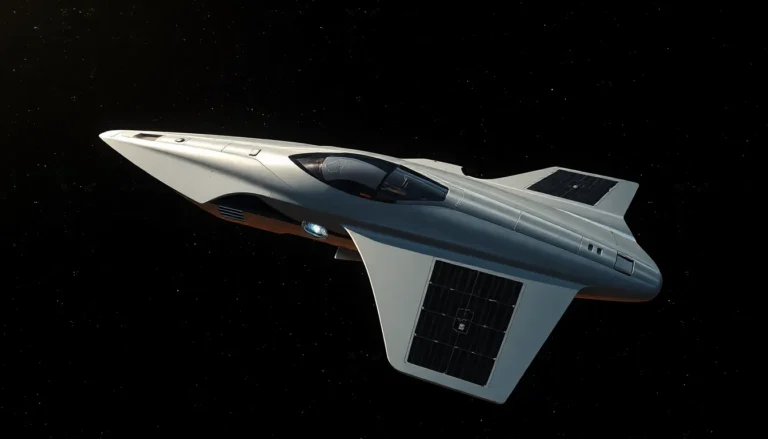Table of Contents
ToggleSpace exploration isn’t just about astronauts floating around in zero gravity or dodging space debris like it’s an intergalactic game of dodgeball. It’s also about the incredible tools that make these adventures possible. From rovers that boldly roll across Mars to telescopes that peer into the depths of the universe, these gadgets turn science fiction into reality.
Overview of Space Exploration Tools
Space exploration tools encompass a variety of instruments designed for different missions and environments. Rovers serve a critical function on extraterrestrial surfaces, enabling direct sampling and analysis of soil and rock. An example includes NASA’s Perseverance rover, which seeks signs of ancient life on Mars.
Satellites play a crucial role in gathering data from vast distances. They provide communications and Earth observations, enhancing weather forecasting and disaster management. Instruments aboard satellites, such as spectrometers, analyze atmospheric composition to track changes over time.
Telescopes, particularly space-based ones like the Hubble Space Telescope, reveal distant galaxies and celestial phenomena. These instruments capture light from the universe, allowing scientists to study the cosmos without atmospheric interference.
Robotic arms and other mechanisms assist in assembling and repairing space structures. The International Space Station employs robotic systems to maintain its functionality and support astronauts during their missions.
Instruments like spectrometers and magnetometers onboard space missions focus on analyzing planetary atmospheres and surface conditions. These tools help determine the viability of life and resource availability.
Drones increasingly supplement terrestrial exploration efforts, providing aerial views and collecting data in environments unsuitable for humans. They enhance reconnaissance capabilities during missions on planetary bodies.
Combined, these tools advance human understanding of space, facilitating discoveries that inspire future explorations.
Types of Space Exploration Tools
Space exploration utilizes various advanced tools that enhance our ability to study and understand the cosmos. These tools serve different purposes, each contributing uniquely to scientific missions.
Robotic Spacecraft
Robotic spacecraft handle a variety of tasks in outer space. These machines explore planets, moons, and asteroids without human presence. NASA’s Voyager probes, for example, have traveled beyond the solar system, sending back invaluable data. Data analysis from these probes enhances knowledge of interstellar space. Such vehicles often feature sophisticated instruments for imaging and collecting samples. They operate in extreme conditions, demonstrating durability and adaptability.
Rovers
Rovers play a vital role in planetary exploration. NASA’s Perseverance and Curiosity actively analyze soil and rock samples on Mars. These wheeled robots carry equipment for assessing climates and searching for signs of past life. They can navigate rugged terrains autonomously, transmitting high-resolution images and data back to Earth. Research conducted by rovers contributes to understanding planetary geology. They test equipment and techniques for future human missions on Mars and beyond.
Satellites
Satellites are essential for communication and Earth observation. Systematic deployment of these tools allows for monitoring weather patterns, climate changes, and natural disasters. Satellites like NOAA’s GOES provide real-time data crucial for predicting severe weather. Data from satellites supports scientific research and enhances understanding of Earth’s environment. They contribute to telecommunications, GPS, and navigation systems. These tools ensure a constant flow of information vital to numerous industries and scientific endeavors.
Key Technologies in Space Exploration
Various technologies enable successful space exploration. These tools allow missions to gather critical data and foster understanding of the cosmos.
Navigation Systems
Navigation systems play a vital role in guiding spacecraft through the vastness of space. They utilize Global Positioning System (GPS) satellites, star trackers, and inertial measurement units for precise navigation. For example, NASA’s Mars Rover relies on advanced algorithms to navigate the Martian terrain autonomously. Systems employ ground control communications to adjust trajectories during a mission. These specialized navigation tools ensure safe and efficient travel to destination points, whether it’s a landing on the Moon or an orbit around Mars.
Communication Tools
Communication tools are essential for transmitting data between spacecraft and mission control. They include high-frequency radio antennas and laser communication systems. NASA’s Deep Space Network maintains constant communication with distant spacecraft, enabling data transfer over millions of miles. These tools support real-time monitoring and command issuing, fostering collaboration among scientists globally. Advanced encoding techniques enhance data security during transmission, preserving valuable information from space missions.
Scientific Instruments
Scientific instruments facilitate the collection and analysis of data from extraterrestrial environments. These instruments include spectrometers, cameras, and radiation detectors. For instance, the Mars Perseverance Rover carries a suite of instruments designed to analyze soil and rock samples. Instruments on space telescopes like the Hubble capture images of distant galaxies, enhancing our understanding of the universe. Innovations in these tools allow researchers to conduct experiments in situ, leading to significant discoveries and advancements in space science.
Future Trends in Space Exploration Tools
Future trends in space exploration tools focus on enhancing efficiency and improving mission outcomes. Innovations in technology drive advancements that push the boundaries of what’s possible in space.
Advancements in Robotics
Robotics continue to revolutionize space exploration. Advanced robotic systems are capable of performing complex tasks, such as sample collection and analysis on planetary surfaces. NASA’s upcoming missions plan to deploy more sophisticated rovers equipped with enhanced mobility and precision tools. Multimodal robots could explore various terrains, facilitating more extensive data collection. Enhanced dexterity in robotic arms allows for intricate repairs and maintenance on spacecraft and space stations. These advancements not only reduce the risk to human astronauts but also maximize the potential for groundbreaking discoveries.
The Role of Artificial Intelligence
Artificial intelligence plays a crucial role in processing vast amounts of data gathered during space missions. AI algorithms analyze signals from deep space, identifying patterns and anomalies that human operators might overlook. Advanced machine learning techniques improve decision-making processes in real time, enabling spacecraft to adapt to changing environments. Future missions intend to integrate AI systems for autonomous navigation, allowing spacecraft to chart courses without constant human intervention. Intelligent systems can prioritize tasks, optimizing the overall mission efficiency and enhancing scientific output.
Conclusion
Space exploration tools are essential for unraveling the mysteries of the universe. From rovers that traverse alien landscapes to advanced telescopes that peer into the depths of space, these technologies enable profound discoveries. As innovations continue to emerge, the future of space exploration looks promising with enhanced robotics and artificial intelligence set to transform missions.
The ongoing evolution of these tools not only supports current scientific endeavors but also paves the way for ambitious future explorations. By investing in and developing these technologies, humanity can push the boundaries of knowledge and inspire generations to come. The journey through the cosmos is just beginning, and the tools at our disposal will play a pivotal role in shaping that adventure.







